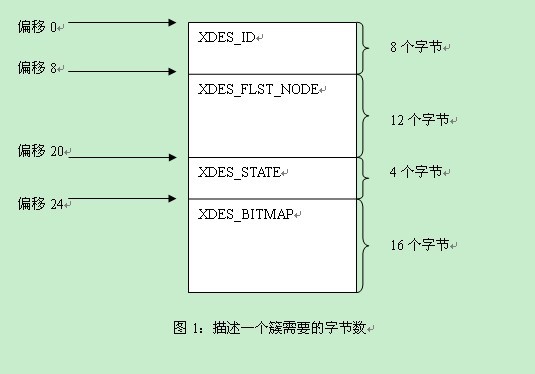思考mysql内核之初级系列12---innodb的簇描述结构
在上一篇里,bingxi和alex聊了关于innodb的页编号。在本篇,bingxi和alex会讨论下簇描述结构。所谓的簇描述结构,对应的英文描述是extent,表达的意思是一些连续的页。
对应的文件为:
D:\mysql-5.1.7-beta\storage\innobase\fsp\ fsp0fsp.c
D:\mysql-5.1.7-beta\storage\innobase\include\ fsp0fsp.h
1)簇的定义
Bingxi:“alex,在共享存储空间的情况,多个innodb表存储在同一个表空间里面。对单个表而言,存储并不一定是连续的。在上一篇里面提到这样的一个例子:
a)创建表1,并插入数据
b)创建表2,并插入数据
c)表1插入数据
d)表2插入数据
如果我们每次分配一个页,就会存储得很凌乱。可能第n页属于t1,n+1页属于t2,n+3页属于t1,n+4页属于t2,……
这样就会降低io的读写性能,因此我们可以看到在mysql中有簇的概念,这里的簇也就是指extent。簇是连续的页,数量是64页。那么我问下alex,假设T1表新分配了一个簇,某些页用完了,如何标识?
”
Alex:“bingxi,我也存在这个疑惑。我们用过代码来看这个问题吧。代码如下:
/* EXTENT DESCRIPTOR
=================
File extent descriptor data structure: contains bits to tell which pages in
the extent are free and which contain old tuple version to clean. */
/*-------------------------------------*/
#define XDES_ID 0 /* The identifier of the segment
to which this extent belongs */
#define XDES_FLST_NODE 8 /* The list node data structure
for the descriptors */
#define XDES_STATE (FLST_NODE_SIZE + 8)
/* contains state information
of the extent */
#define XDES_BITMAP (FLST_NODE_SIZE + 12)
/* Descriptor bitmap of the pages
in the extent */
定义里面的数字是偏移量,我们来画个图看下。

从上面我们可以知道:
XDES_ID //0
XDES_FLST_NODE //8
XDES_STATE //20
XDES_BITMAP //24
这些内容中,我们会产生两个疑问:1)16个字节描述64个页的使用状态,怎么描述?如果只是描述该页是否使用,1个bit位就够了,也就是64个bit位,即8个字节。而实际使用了16个字节,那么是不是可以认为是两个bit位来描述一个页的使用情况。2)每个簇使用40个字节,这些内容存储在什么地方?
Bingxi,你来看看。我们在本篇中,先解决第一个问题,第二个问题留到下一篇。
”
Bingxi:“第一个问题,可以理解。
//每个页需要两个bit位来描述
#define XDES_BITS_PER_PAGE 2 /* How many bits are there per page */
//这两个bit位中,第一个bit位标识该页是否在使用
#define XDES_FREE_BIT 0 /* Index of the bit which tells if
the page is free */
//第二个标识位目前没有使用
#define XDES_CLEAN_BIT 1 /* NOTE: currently not used!
Index of the bit which tells if
there are old versions of tuples
on the page */
每个页使用两个位,那么64个页使用的就是16个字节。我们看一下簇的初始化代码:
/**************************************************************************
Inits an extent descriptor to the free and clean state. */
UNIV_INLINE
void
xdes_init(
/*======*/
xdes_t* descr, /* in: descriptor */
mtr_t* mtr) /* in: mtr */
{
ulint i;
ut_ad(descr && mtr);
ut_ad(mtr_memo_contains(mtr, buf_block_align(descr),
MTR_MEMO_PAGE_X_FIX));
ut_ad((XDES_SIZE - XDES_BITMAP) % 4 == 0);
//其中XDES_BITMAP的值为24
// XDES_SIZE的大小为40
//也就是簇描述结构中24字节开始的16个字节全部设置为1
for (i = XDES_BITMAP; i < XDES_SIZE; i += 4) {
mlog_write_ulint(descr + i, 0xFFFFFFFFUL, MLOG_4BYTES, mtr);
}
//设置簇的使用状态为空闲簇
xdes_set_state(descr, XDES_FREE, mtr);
}
我们接着看xdes_set_state的实现:
/**************************************************************************
Sets the state of an xdes. */
UNIV_INLINE
void
xdes_set_state(
/*===========*/
xdes_t* descr, /* in: descriptor */
ulint state, /* in: state to set */
mtr_t* mtr) /* in: mtr handle */
{
ut_ad(descr && mtr);
ut_ad(state >= XDES_FREE);
ut_ad(state <= XDES_FSEG);
ut_ad(mtr_memo_contains(mtr, buf_block_align(descr),
MTR_MEMO_PAGE_X_FIX));
// descr是该簇的起始指针,相对该指针XDES_STATE的开始4个字节填写status的值
mlog_write_ulint(descr + XDES_STATE, state, MLOG_4BYTES, mtr);
}
同样的,获取状态也是类似的。我们接着看下xdes_get_n_used函数,该函数表述该簇的页已经使用了多少。
/**************************************************************************
Returns the number of used pages in a descriptor. */
UNIV_INLINE
ulint
xdes_get_n_used(
/*============*/
/* out: number of pages used */
xdes_t* descr, /* in: descriptor */
mtr_t* mtr) /* in: mtr */
{
ulint i;
ulint count = 0;
ut_ad(descr && mtr);
ut_ad(mtr_memo_contains(mtr, buf_block_align(descr),
MTR_MEMO_PAGE_X_FIX));
//对该簇的每一页调用函数xdes_get_bit
// xdes_get_bit函数返回对应页的是否使用位
//我们从初始化函数中知道,1表示使用,0表示未使用
//因为如果函数返回的值是false,则表示该页已经使用了,将count加1
for (i = 0; i < FSP_EXTENT_SIZE; i++) {
if (FALSE == xdes_get_bit(descr, XDES_FREE_BIT, i, mtr)) {
count++;
}
}
return(count);
}
如果所有的页都使用完,那么就表示该页已经使用满。
/**************************************************************************
Returns true if extent contains no free pages. */
UNIV_INLINE
ibool
xdes_is_full(
/*=========*/
/* out: TRUE if full */
xdes_t* descr, /* in: descriptor */
mtr_t* mtr) /* in: mtr */
{
//如果该簇使用的页等于64(FSP_EXTENT_SIZE),也就是表示该簇已经满了
if (FSP_EXTENT_SIZE == xdes_get_n_used(descr, mtr)) {
return(TRUE);
}
return(FALSE);
}
其它的函数类似,这里就不一一列举。作为重点,我们再看一下xdes_set_bit函数。
/**************************************************************************
Sets a descriptor bit of a page. */
UNIV_INLINE
void
xdes_set_bit(
/*=========*/
xdes_t* descr, /* in: descriptor */
ulint bit, /* in: XDES_FREE_BIT or XDES_CLEAN_BIT */
ulint offset, /* in: page offset within extent:
0 ... FSP_EXTENT_SIZE - 1 */
ibool val, /* in: bit value */
mtr_t* mtr) /* in: mtr */
{
ulint index;
ulint byte_index;
ulint bit_index;
ulint descr_byte;
ut_ad(mtr_memo_contains(mtr, buf_block_align(descr),
MTR_MEMO_PAGE_X_FIX));
ut_ad((bit == XDES_FREE_BIT) || (bit == XDES_CLEAN_BIT));
ut_ad(offset < FSP_EXTENT_SIZE);
//假设offset的值为n
// XDES_BITS_PER_PAGE为2
//index也就是相对于XDES_BITMAP的偏移bit位
index = bit + XDES_BITS_PER_PAGE * offset;
//index/8对应的是相对于XDES_BITMAP的偏移字节
byte_index = index / 8;
//表示所在的位,这里面要重点关注
//字节是从低字节编码的,比如n对应的bit_index是0,实际上表示的是第0位,而不是第7位。即使xxxxxxxy中的y对应的位。
//假设bit_index为6,实际对应的是xyxxxxxx中的y对应的位。
bit_index = index % 8;
//获得对应的字节
descr_byte = mtr_read_ulint(descr + XDES_BITMAP + byte_index,
MLOG_1BYTE, mtr);
//设置对应的bit位
descr_byte = ut_bit_set_nth(descr_byte, bit_index, val);
//重写入
mlog_write_ulint(descr + XDES_BITMAP + byte_index, descr_byte,
MLOG_1BYTE, mtr);
}
这样,我们对应簇的bit位进行设置,标识对应的页的使用情况。还有一些其他的函数,建议直接看代码。
”
Alex:“ok,今天就到这里吧。”
Bingxi:“ok”
建议继续学习:
- Innodb IO优化-配置优化 (阅读:7478)
- Innodb分表太多或者表分区太多,会导致内存耗尽而宕机 (阅读:7423)
- Innodb 表和索引结构 (阅读:5836)
- InnoDB线程并发检查机制 (阅读:5392)
- Innodb如何使用内存 (阅读:4973)
- Innodb文件表空间结构 (阅读:4939)
- 快速预热Innodb Buffer Pool的方法 (阅读:4817)
- InnoDB的缓存替换策略及其效果 (阅读:4654)
- 多版本并发控制:PostgreSQL vs InnoDB (阅读:4460)
- InnoDB之Dirty Page、Redo log (阅读:4344)
扫一扫订阅我的微信号:IT技术博客大学习
- 作者:yzyangwanfu 来源: 杨万富的专栏
- 标签: innodb mysql内核 簇描述
- 发布时间:2010-08-22 10:04:28
-
 [1199] WordPress插件开发 -- 在插件使用
[1199] WordPress插件开发 -- 在插件使用 -
 [88] 解决 nginx 反向代理网页首尾出现神秘字
[88] 解决 nginx 反向代理网页首尾出现神秘字 -
 [43] web开发设计人员不可不用的在线web工具和
[43] web开发设计人员不可不用的在线web工具和 -
 [30] Rax 系列教程(长列表)
[30] Rax 系列教程(长列表) -
 [29] 一句话crontab实现防ssh暴力破解
[29] 一句话crontab实现防ssh暴力破解 -
 [29] Java开发岗位面试题归类汇总
[29] Java开发岗位面试题归类汇总 -
 [29] 手机产品设计方向
[29] 手机产品设计方向 -
 [28] 如何建立合适的索引?
[28] 如何建立合适的索引? -
 [26] 程序员疫苗:代码注入
[26] 程序员疫苗:代码注入 -
 [25] 我对学习oracle与成长的理解
[25] 我对学习oracle与成长的理解
